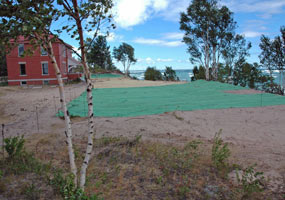|
You are viewing ARCHIVED content published online before January 20, 2025.
Please note that this content is NOT UPDATED, and links may not work. For current information,
visit https://www.nps.gov/aboutus/news/index.htm.
Contact: Gregg Bruff, 906-387-2607, ext. 208

NPS photo The year was 1874. Barbed wire and Levi jeans were patented in the U.S. The "Impressionists" were painting their famous landscapes in France. And the Au Sable Light Station was constructed, 12 miles west of Grand Marais, Michigan, a landmark that celebrates its 133rd birthday this month. While the buildings have aged well, historic photos tell us that the Station has changed in appearance over time. The "L" shaped dock has been taken by the vagaries of wind, ice and waves; trees have grown in as the forest has encroached on the station; and outbuildings like the "hennery" have come and gone. Over the past two decades, Pictured Rocks National Lakeshore has worked to rehabilitate the Station buildings, both interior and exterior in accordance with National Park Service and the Secretary of the Interior's policies for historic structures. Past projects have included reconstruction of the assistant keepers dwelling front porch, interior wall plastering and trim restoration, and roof and chimney work on several buildings. In 1996, the Lakeshore returned the original third order Fresnel lens in the lens room atop the Station tower. Linen curtains were also installed to recreate the historic scene and help protect the fragile lens from light damage. The National Park Service is responsible for the long-term care and interpretation of these historic buildings and the landscape in which they exist. Historically, the U.S. Lighthouse Service, and later the U.S. Coast Guard, would have maintained the grounds in a manner that would reduce the potential for fire or wind-throw tree damage and assure that the light was visible out on the lake some 17 miles. Photographs from the 1880's and 1920's, for example, show a distinct forest perimeter with only grasses and blueberries permitted to grow near the buildings. In 1998 a Cultural Landscape Report was completed for Au Sable, documenting the original landscape elements, the addition and deletion of buildings, and other changes to the appearance of the Station. That study also made recommendations for enhancing the cultural landscape for historic accuracy and visitor enjoyment. Recent projects at Au Sable are meant to further those cultural landscape report recommendations. Two summers ago, a group of church volunteers from Wisconsin spent a week trimming trees and placing brush to reduce sand bank erosion on the lake side of the Station. This summer, Lakeshore maintenance crews have continued that work. Additional trees have been cut to replicate the historic forest perimeter. Brush from these trees has been placed "over the edge" to cover and stabilize sand blowouts that have been exacerbated by visitor foot traffic up and down the slope between the beach and the buildings. This summer, a Lakeshore maintenance crew used a small bulldozer to push sand dunes that had grown on top of the banks back down the slope. While visitors to the site will be surprised at how this has changed the scene, the appearance more closely matches the historic landscape features of the 1910 era. It is this period we are striving for when it comes to historic authenticity of both the buildings and landscape in that 1910 was when the assistant keepers dwelling was made into a duplex, and the new head keepers quarters were constructed. Another related project that will continue is the rehabilitation of the Light Station sidewalk system. Park staff have leveled and reinforced the existing sidewalks. The next phase is to re-create the sidewalk at the Fog Signal building where it has deteriorated and broken. Future work will include additional leveling of the entire site to again approach the appearance of the Station in 1910. This will likely include planting native seeds and seedlings to help slow erosion rates on the sand bluff. So as you visit Au Sable Light Station next time, please notice the fine work completed by park staff as we continue to rehabilitate both the buildings and the historic landscape for its cultural integrity and public safety. Be sure to use the staircase to and from the beach rather than climbing the sand bank that we have worked hard to restore. Think back in time when barbed wire and Levi jeans were invented and picture yourself at the lighthouse in 1874 - or 1910 and dream what it was like to be a keeper of such an important aid to navigation. For additional information, contact Gregg Bruff, Chief of Heritage Education, Visitor Information and Cultural Resources, at 906-387-2607, extension 208. |
Last updated: April 10, 2015
